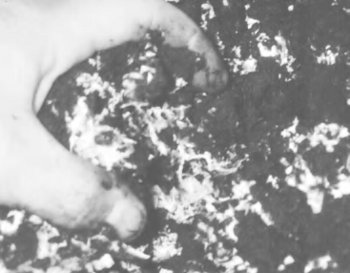Casing
The only method of forcing mushroom mycelia to change from the vegetative phase to a reproductive state is to apply a cover of a suitable material — called the casing layer — on the surface of the spawned compost. The function of a casing layer is to trigger the mushrooms to switch from a vegetative growth to a reproductive or fruiting growth. The mechanism that initiates the spawn to change from vegetative to reproductive growth is unknown, though several theories have been presented. The casing also functions to supply and conserve moisture for the mushrooms and their rhizomorphs (thicker mushroom mycelia) and acts to transport dissolved nutrients to the mushrooms. Casing supports the mushrooms and compensates for water lost through evaporation and transpiration. Rhizomorphs look like thick strings. They are formed when the very fine mycelia fuse together and grow through the casing. Rhizomorphs are thought to carry water and nutrients from the compost to the developing mushrooms (Figure 13). Mushroom initials — primordia or pins — form on the rhizomorphs. Without rhizomorphs, there will be no mushrooms.

Figure 13. Spawn growth in the casing and its thicker rhizomorph growth.
The mushroom industry uses various materials to provide a suitable environment for fruit body formations. Presently, most mushroom growers
use sphagnum peat moss or aged sphagnum peat moss buffered with limestone. Sphagnum peat is relatively inexpensive and readily available to North American growers. Pasteurized clay loam field soil; reclaimed, weathered, spent compost; and coir fibers are other materials used by
growers.
Most sphagnum peat has a pH of 3.5 to 4.5. A neutralizing agent — usually calcium limestone — is added to bring the pH level up to 7.5. Processed, spent sugar beet lime or hydrated lime can be used. Due to its higher neutralizing capability and its greater solubility, only small amounts are required.
Soil, spent mushroom substrate, and coir fibers should be pasteurized to eliminate any insects and pathogens they may be carrying. However, peat moss–based casing does not need pasteurization because it is inherently free of mushroom disease spores and pests. Distributing the casing so the depth and moisture are uniform over the surface of the compost is important. Such uniformity allows spawns to move into and through the casing at the same rate and, ultimately, for mushrooms to develop at the same time. Casing should be able to hold moisture because moisture is essential for the development of a firm mushroom.
3467 view.